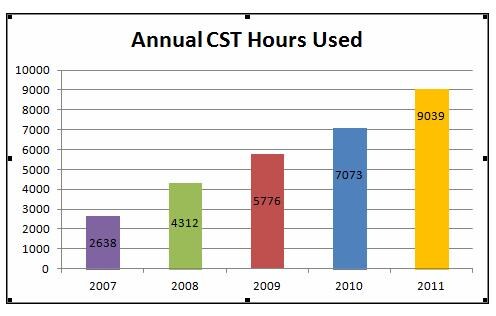Corporate Social Responsibility: The Hypertherm Way
Participation on the Philanthropy Team, and its sub-committees, also provides opportunities for Associates to develop leadership skills


Hypertherm is a small, private company located in Lebanon, New Hampshire, that designs and manufactures advanced metal cutting equipment. Although most of its work in the area Corporate Social Responsibility is done by volunteers, it has achieved some remarkable results. For example, in its annual Associate Satisfaction Survey, 97% of the employees wrote that they ‘agree’ or ‘strongly agree’ with the statement: “I feel good about the ways Hypertherm contributes to the community.” In this blog, I want to highlight three of Hypertherm’s practices that are particularly innovative and effective.
Delegating Decision Making
Each year, senior management at Hypertherm decides how much the company will donate to nonprofit organizations in the communities where employees live and work. However, it is the Philanthropy Team made up of Associates, who decide which nonprofit organizations to fund. The Philanthropy Team is currently made up of volunteers from across the organization, who work in marketing, production, engineering and sales. The chair is Kim Smith, a sales team leader.
Most companies who engage in philanthropy want their employees to take pride in this altruistic activity. Delegating this decision making to a rotating group of Associates adds considerable credibility to the process and sends a powerful message that grants will be awarded based on the quality of the proposal and the needs of the community. Participation on the Philanthropy Team, and its sub-committees, also provides opportunities for Associates to develop leadership skills.
Community Service
Hypertherm is quantitatively oriented. It uses surveys and other data rich feedback in all its lines of business, and community service is no exception. In 2003, Hypertherm launched a new community services program which encourages Associates to work on volunteer projects with local nonprofit organizations. Each Associate receives two days of paid time (recently raised to three days) annually.
A growing number of companies give their employees some paid time to volunteer and, like Hypertherm, some also provide electronic postings of volunteer opportunities. What is unusual about Hypertherm is that it tracks the usage of volunteer time and sets annual goals. In 2007, the Philanthropy Team noted that only about 2,600 hours were being used by Associates annually, or approximately 20% of total available hours. So it formed a sub-committee (the CST subcommittee) to see why more Associates were not taking advantage of this opportunity.
The CST subcommittee did some in-depth analysis and came to two conclusions: 1) that the problem was not a lack of good, volunteer opportunities, but a shortage of group projects, and 2) that getting Associates to use one hour of community service time will be infectious and lead to more usage. Associates, they concluded, were much more likely to volunteer if their whole department could participate together. So the Philanthropy Team looked for more opportunities where Associates could do things like trail maintenance, community dinners and home repairs.
As the chart below shows, each year since 2007, the number of community service hours has increased significantly. In terms of participation, in 2010, the Philanthropy team set a goal of 60% participation and achieved 66%. In 2011, participation in grew to 78% against a goal of 70%. Hypertherm’s 2012 goal is 80% participation.One important benefit of this emphasis on getting people to try community service is that it results in wider participation throughout the company. While it is easier for office workers to take a day off, with enough planning, Associates working in manufacturing and on the production lines also found ways to use their two days of paid, community service time.
Environmental Sustainability
In 2010, as part of its Corporate Social Responsibility program, Hypertherm decided that it needed to improve its environmental stewardship. The top leadership team developed a set of ambitious environmental sustainability goals and challenged the company to meet them by 2020. Hypertherm established goals in the areas of waste reduction, energy efficiency and carbon impacts. For example, by 2020, Hypertherm’s goal is to reduce waste going to landfills to zero. In the area of carbon impacts, Hypertherm set a goal of reducing its carbon footprint by 50%, which means being strategic and efficient in planning business trips and, where possible, shipping goods by boat rather than by plane. Being data driven, Hypertherm is tracking progress on a yearly basis on nine different environmental metrics.
As the emphasis on environmental sustainability has taken root across the company through: corporate metrics, integration into annual team operating plans, impact area working groups with deployment action plans, and team Green Champions, there have been some nice dividends. For example, one Associate suggested putting shutoff valves on three laboratory cutting tables which resulted in a savings of 1,200 gallons of water per day.
Upgrading and utilizing state-of-the-art building controls software has allowed Hypertherm to achieve over $30,000 in annual electricity savings on the off-hours in one building. Switching from plastic tubs to refill pouches for grease wipes resulted in a $7,400 annual savings and a reduction of 2000 pounds of waste. Cost saving are nice, but Hypertherm’s primary motivation in establishing these challenging goals is because environmental sustainability fits with and reinforces the company’s core values.
Why They Do It
In the 2011 Corporate Social Responsibility Annual Report, Barbara Couch, Vice President for Corporate Social Responsibility nicely explains why Hypertherm does community service, which also speaks to their whole approach to Corporate Social Responsibility. She writes: “We have found that when Associates have the opportunity to give back, to give time to their communities, they return to Hypertherm with a renewed sense of purpose and fulfillment. We are building stronger communities and creating a more dedicated and engaged workforce.”
First Published: Jun 22, 2012, 06:39
Subscribe Now